Destination Service Encounter Modeling and Relationships with Tourist Satisfaction
Abstract
:1. Introduction
2. Literature Review
2.1. Conceptualization of DSEs
2.2. Dimensions of DSEs
2.2.1. Enterprise Service Encounters
2.2.2. Public Service Encounters
2.3. The RelationshipsBetween DSEs and TS
- H1:
- EPIEs are a significantly positive predictor of TS.
- H2:
- EPEEs are a significantly positive predictor of TS.
- H3:
- PPIEs are a significantly positive predictor of TS.
- H4:
- PPEEs are a significantly positive predictor of TS.
3. Development and Validation of DSEs
3.1. Context and Procedures
3.2. Step 1: Item Generation of PSEs
3.2.1. Interview Preparation
3.2.2. Interviews
3.2.3. Interview Data Coding
3.3. Step 2: Item Generation and Content Validity Assessment
3.4. Step 3: Pilot Surveys
3.5. Step 4: Primary Survey
3.6. Step 5: Reliability and Validity Assessment
3.6.1. Reliability
3.6.2. Structural Validity
3.6.3. Common Method Variance
3.7. The Effects of DSEs on TS
4. Conclusions and Implications
4.1. Discussions
4.2. Implications
4.3. Limitations and Future Research Directions
Author Contributions
Funding
Conflicts of Interest
Appendix A. Semi-Structured Interview Outline
- What are your feelings about the destination’s (i.e., the Shaoshan township) public infrastructure, such as public transportation, public toilets, urban greening, public security, etc.?
- What are your feelings about the destination’s public tourism attractions, such as urban parks, public leisure facilities, natural and cultural landscape, museums, etc.?
- What are your feelings about the destination’s public transportation system for tourists, such as sightseeing buses, parking lots, traffic signs, cruises and wharfs, transfer stations, etc.?
- What are your feelings about the destination’s market order regulation?
- What are your feelings about the visitors’ rights protection, such as complaints handling, safety guarantee, travel insurance, etc.?
- What are your feelings about the destination’s information services, such as tourism hotline, tourist information center, free tourism information, etc.?
- What are your feelings about the service attitude toward the public personnel at the destination?
- What are your feelings about the behaviors of the public service personnel at the destination?
- What are your feelings about the expertise of the public service personnel at the destination?
References
- UNWTO. Tourism Highlights 2018 Edition. Available online: https://www.e-unwto.org/doi/pdf/10.18111/9789284419876 (accessed on 23 December 2017).
- Su, L.; Swanson, S.R.; Chen, X. The effects of perceived service quality on repurchase intentions and subjective well-being of Chinese tourists: The mediating role of relationship quality. Tour. Manag. 2016, 52, 82–95. [Google Scholar] [CrossRef]
- Keng, C.J.; Huang, T.L.; Zheng, L.J.; Hsu, M.K. Modeling service encounters and customer experiential value in retailing: An empirical investigation of shopping mall customers in Taiwan. Int. J. Serv. Ind. Manag. 2007, 18, 349–367. [Google Scholar] [CrossRef]
- Wu, C.H.-J.; Liang, R.-D. Effect of experiential value on customer satisfaction with service encounters in luxury-hotel restaurants. Int. J. Hosp. Manag. 2009, 28, 586–593. [Google Scholar] [CrossRef]
- Solomon, M.R.; Surprenant, C.; Czepiel, J.A.; Gutman, E.G. A Role Theory Perspective on Dyadic Interactions: The Service Encounter. J. Mark. 1985, 49, 99–111. [Google Scholar] [CrossRef]
- Gallouj, F.; Weinstein, O. Innovation in services. Res. Policy 1997, 26, 537–556. [Google Scholar] [CrossRef]
- Carlzon, J. Moments of Truth; Harper Paperbacks: New York, NY, USA, 1989. [Google Scholar]
- Bitner, M.J. Servicescapes: The Impact of Physical Surroundings on Customers and Employees. J. Mark. 1992, 56, 57–71. [Google Scholar] [CrossRef]
- Baum, T. Making or breaking the tourist experience: The role of human resource management. In The Tourist Experience; Ryan, C., Ed.; Continuum: London, UK, 2002; pp. 94–111. [Google Scholar]
- Solnet, D. Employee—Customer Linkages: A Social Identification Perspective in a Hotel Industry Context. J. Hosp. Tour. Res. 2007, 14, 129–143. [Google Scholar] [CrossRef]
- Abubakar, B.; Mavondo, F. Tourism destinations: Antecedents to customer satisfaction and positive word-of-mouth. J. Hosp. Mark. Manag. 2014, 23, 833–864. [Google Scholar] [CrossRef]
- Tan, S.E.; Aziz, Y.A.; Khairi, W.A.; Zaiton, S. Linking Servicescape, Tourist Satisfaction and Overall Tour Guiding Experience: The Case of Taman Negara National Park, Malaysia. Pertanika J. Soc. Sci. Hum. 2015, 23, 33–48. [Google Scholar]
- Norman, R.J. Service Management: Strategy and Leadership in Service Businesses; Wiley: Hoboken, NJ, USA, 1986. [Google Scholar]
- Shostack, G.L. Planning the Service Encounter; Lexington Books: Lexington, MA, USA, 1985. [Google Scholar]
- Xu, J.; Pan, Y. Theoretical Cognition and Practical Judgment of Tourism Public Service—A Concurrent Discussion with Shuang Li. Tour. Tribune 2014, 29, 27–38. (In Chinese) [Google Scholar]
- Okuyama, T.; Ishihara, H. Effects of Improving Public Services for Tourism Developments in Islands: The Case of Remote Islands in Nagasaki, Japan. Open J. Soc. Sci. 2015, 3, 114–126. [Google Scholar] [CrossRef]
- Thompson, K.; Schofield, P. An investigation of the relationship between public transport performance and destination satisfaction. J. Transp. Geogr. 2007, 15, 136–144. [Google Scholar] [CrossRef]
- Cheng, D.; Cheng, J.; Xiao, T. Examining the Structural Relationships of Tourism Public Service System and Destination Satisfaction—A Case Study of Guilin National Tourism Reform Experimental Zone. Hum. Geogr. 2011, 26, 111–116. (In Chinese) [Google Scholar]
- Guan, X.; Li, J.; Xie, L. The Impact of Tourism Public Service Quality on Destination Image. Tour. Sci. 2015, 29, 27–38. [Google Scholar]
- Lin, I.Y.; Mattila, A.S. Restaurant servicescape, service encounter, and perceived congruency on customers’ emotions and satisfaction. J. Hosp. Market. Manag. 2010, 19, 819–841. [Google Scholar] [CrossRef]
- Gronroos, C. Service management: A management focus for service competition. Int. J. Serv. Ind. Manag. 1990, 1, 6–14. [Google Scholar] [CrossRef]
- Brady, M.K.; Cronin, J.J. Some new thoughts on conceptualizing perceived service quality: A hierarchical approach. J. Mark. 2001, 65, 34–49. [Google Scholar] [CrossRef]
- Baker, J. The role of the environment in marketing services: The consumer perspective. In The Services Challenge: Integrating for Competitive Advantage; American Marketing Association: Chicago, IL, USA, 1986. [Google Scholar]
- Bitner, M.J. Evaluating Service Encounters: The Effects of Physical Surroundings and Employee Responses. J. Mark. 1990, 54, 69–82. [Google Scholar] [CrossRef]
- Surprenant, C.F.; Solomon, M.R. Predictability and Personalization in the Service Encounter. J. Mark. 1987, 51, 86–96. [Google Scholar] [CrossRef]
- Yi, Y.; Gong, T. An integrated model of customer social exchange relationship: The moderating role of customer experience. Serv. Ind. J. 2009, 29, 1513–1528. [Google Scholar] [CrossRef]
- Connell, J.; Reynolds, P. The implications of technological developments on Tourist Information Centres. Tour. Manag. 1999, 20, 501–509. [Google Scholar] [CrossRef]
- Albalate, D.; Bel, G. Tourism and urban public transport: Holding demand pressure under supply constraints. Tour. Manag. 2010, 31, 425–433. [Google Scholar] [CrossRef]
- Pearce, D.G. Tourism development in Paris: Public intervention. Ann. Touris. Res. 1998, 25, 457–476. [Google Scholar] [CrossRef]
- Heggie, T.W.; Heggie, T.M.; Kliewer, C. Recreational Travel Fatalities in US National Parks. J. Travel Med. 2010, 15, 404–411. [Google Scholar] [CrossRef]
- Keh, H.T.; Ren, R.; Hill, S.R.; Li, X. The beautiful, the cheerful, and the helpful: The effects of service employee attributes on customer satisfaction. Psychol. Mark. 2013, 30, 211–226. [Google Scholar] [CrossRef]
- Winsted, K.F. Service behaviors that lead to satisfied customers. Eur. J. Mark. 2000, 34, 399–417. [Google Scholar] [CrossRef]
- Choo, H.S.; Petrick, J.F. Social interactions and intentions to revisit for agritourism service encounters. Tour. Manag. 2014, 40, 372–381. [Google Scholar] [CrossRef]
- Mehrabian, A.; Russell, J.A. An Approach to Environmental Psychology; MIT: Cambridge, UK, 1980. [Google Scholar]
- Wakefield, K.L.; Blodgett, J.G. The Importance of Servicescapes in Leisure Service Settings. J. Serv. Mark. 1994, 8, 66–76. [Google Scholar] [CrossRef]
- Kettl, D.F. Civil Service Reform: Building a Government That Works. Public Admin. Rev. 2007, 62, 634–637. [Google Scholar]
- Meer, F.M.V.D.; Toonen, T.A.J. Competency management and civil service professionalism in Dutch central government. Public Admin. 2005, 83, 839–852. [Google Scholar] [CrossRef]
- Tiancole, S.; Crompton, J.L.; Willson, V.L. An empirical investigation of the relationships between service quality, satisfaction and behavioral intentions among visitors to a wildlife refuge. J. Leisure Res. 2002, 34, 1–24. [Google Scholar] [CrossRef]
- Prayag, G. Tourists’ Evaluations of Destination Image, Satisfaction, and Future Behavioral Intentions—The Case of Mauritius. J. Travel. Tour. Mark. 2009, 26, 836–853. [Google Scholar] [CrossRef]
- Data Center of China National Tourism Administration. Annual Tourism Statistics Report of 2016 and Forecast of Tourism Economic Situation in 2017. Available online: http://www.cnta.gov.cn/zwgk/lysj/201711/t20171108_846343.shtml (accessed on 20 December 2017).
- China National Tourism Administration (CNTA). Whole domain Tourism Development Report 2017. Available online: http://www.cnta.gov.cn/zwgk/tzggnew/gztz/201708/P020170822603620823148.pdf (accessed on 20 December 2017).
- Li, S.; Huang, F.; Li, J. Tourism Public Service: Connotation, Characteristics and Classification Framework. Tour. Tribune 2010, 25, 20–26. [Google Scholar]
- Churchill, G.A. A Paradigm for Developing Better Measures of Marketing Constructs. J. Mark. Res. 1979, 16, 64–73. [Google Scholar] [CrossRef]
- Cabiddu, F.; Lui, T.-W.; Piccoli, G. Managing Value Co-Creation in the Tourism Industry. Ann. Tour. Res. 2013, 42, 86–107. [Google Scholar] [CrossRef]
- Miles, M.B.; Huberman, A.M. Qualitative Data Analysis, 2nd ed.; Sage: Thousand Oaks, CA, USA, 1994; p. 2. [Google Scholar]
- Strauss, A.L.; Corbin, J.M. Basics of Qualitative Research: Techniques and Procedures for Developing Grounded Theory; Sage: Thousand Oaks, CA, USA, 1998. [Google Scholar]
- Marques, J.F.; Mccall, C. The application of interrater reliability as a solidification instrument in a phenomenological study. Qual. Rep. 2005, 10, 439–462. [Google Scholar]
- Hightower, R.; Brady, M.K.; Baker, T.L. Investigating the role of the physical environment in hedonic service consumption: An exploratory study of sporting events. J. Bus. Res. 2002, 55, 697–707. [Google Scholar] [CrossRef]
- Hutchinson, J.; Lin, F.; Wang, Y. Understanding the relationship of quality, value, equity, satisfaction, and behavioral in tent ions among golf travelers. Tour. Manag. 2009, 30, 298–308. [Google Scholar] [CrossRef]
- Brown, T.; Churchill, G.J.; Peter, J. Research note:Improving the measurement of service quality. J. Retail. 1993, 69, 127–139. [Google Scholar] [CrossRef]
- Chen, C.-C.; Petrick, J.F. The Roles of Perceived Travel Benefits, Importance, and Constraints in Predicting Travel Behavior. J. Travel. Res. 2014, 55, 509–522. [Google Scholar] [CrossRef]
- Cattell, R.B. The scree plot for the number of factors. Multivar. Bahav. Res. 1966, 1, 245–276. [Google Scholar] [CrossRef] [PubMed]
- Hair, J.F.; Black, W.C.; Babin, B.J.; Anderson, R.E.; Tatham, R.L. Multivariate Data Analysis, 6th ed.; Pearson/Prentice Hall: Upper Saddle River, NJ, USA, 2006. [Google Scholar]
- Statistics Bureau of Shaoshan City. National Economic and Social Development Statistics Bulletin of Shaoshan City in 2016. Available online: http://www.shaoshan.gov.cn/Item/95033.aspx (accessed on 20 December 2017).
- Harris, S.G.; Mossholder, K.W. The affective implications of perceived congruence with culture dimensions during organizational transformation. J. Manag. 1996, 22, 527–547. [Google Scholar] [CrossRef]
- Netemeyer, R.G.; Bearden, W.O.; Sharma, S. Scaling Procedures: Issues and Applications; Sage: Thousand Oaks, CA, USA, 2003; p. S10. [Google Scholar]
- So, K.K.F.; King, C.; Sparks, B. Customer Engagement with Tourism Brands. J. Hosp. Tour. Res. 2012, 38, 304–329. [Google Scholar] [CrossRef]
- Bentler, P.M. Comparative fit indexes in structural models. Psychol. Bull. 1990, 107, 238–246. [Google Scholar] [CrossRef]
- Perakovic, D.; Jovović, I.; Forenbacher, I. Improving Croatian Tourist Information Via Location-Based Public Service Through Mobile Phones. In Proceedings of the 4th International Conference on Methodologies, Technologies and Tools Enabling e-Government (MeTTeG), Olten, Switzerland, 1–2 July 2010. [Google Scholar]
- Mariani, M.M.; Borghi, M.; Kazakov, S. The role of language in the online evaluation of hospitality service encounters: An empirical study. Int. J. Hosp. Manag. 2019, 78, 50–58. [Google Scholar] [CrossRef]
- Svinhufvud, K. Waiting for the customer: Multimodal analysis of waiting in service encounters. J. Prag. 2018, 129, 48–75. [Google Scholar] [CrossRef]
- Söderlund, M. Employee display of burnout in the service encounter and its impact on customer satisfaction. J. Retail. Consum. Serv. 2017, 37, 168–176. [Google Scholar] [CrossRef]
- Söderlund, M.; Oikarinen, E.L. Joking with customers in the service encounter has a negative impact on customer satisfaction: Replication and extension. J. Retail. Consum. Serv. 2018, 42, 55–64. [Google Scholar] [CrossRef]
- Sukhu, A.; Bilgihan, A.; Seo, S. Willingness to pay in negative restaurant service encounters. Int. J. Hosp. Manag. 2017, 65, 11–19. [Google Scholar] [CrossRef]
- Sundaram, D.; Webster, C. The role of nonverbal communication in service encounter. J. Serv. Mark. 2000, 14, 378–391. [Google Scholar] [CrossRef]
- Ittelson, W.H.; Proshansky, H.M.; Rivlin, L.G.; Winkel, G.H. An Introduction to Environmental Psychology; Holt, Rinehart and Winston: New York, NY, USA, 1974. [Google Scholar]
- Su, L.; Swanson, S.R.; Chinchanachokchai, S.; Hsu, M.K.; Chen, X. Reputation and intentions: The role of satisfaction, identification, and commitment. J. Bus. Res. 2016, 69, 3261–3269. [Google Scholar] [CrossRef]
- Wang, C.; Hsu, M. The relationships of destination image, satisfaction, and behavioral intentions: An integrated model. J. Travel. Tour. Mark. 2010, 27, 829–843. [Google Scholar] [CrossRef]
- Zhao, M.; Liu, S.J. The impact of tour quality and tourist satisfaction on tourist loyalty: The case of Chinese tourists in Korea. Tour. Manag. 2011, 32, 1115–1124. [Google Scholar]
- Tran, H.A.T.; Hwang, Y.S.; Yu, C.; Yoo, S.J. The Effect of Destination Social Responsibility on Tourists’ Satisfaction: The Mediating Role of Emotions. Sustainability 2018, 10, 3044. [Google Scholar] [CrossRef]
- Palmer, A.; Bejou, D. Tourism destination marketing alliances. Ann. Tourism. Res. 1995, 22, 616–629. [Google Scholar] [CrossRef]
- Voorhees, C.M.; Fombelle, P.W.; Gregoire, Y.; Bone, S.; Gustafsson, A.; Sousa, R.; Walkowiak, T. Service encounters, experiences and the customer journey: Defining the field and a call to expand our lens. J. Bus. Res. 2017, 79, 269–280. [Google Scholar] [CrossRef]
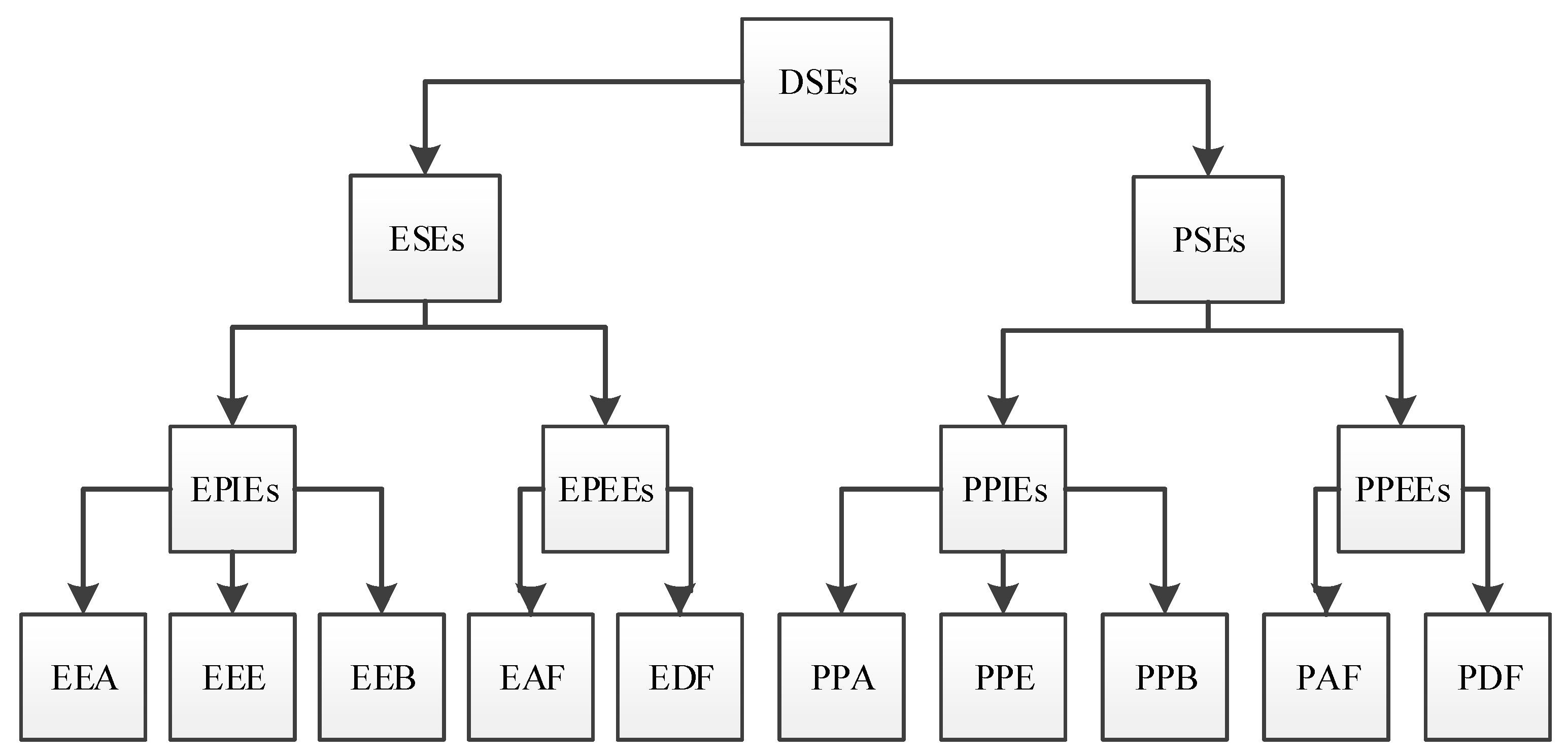
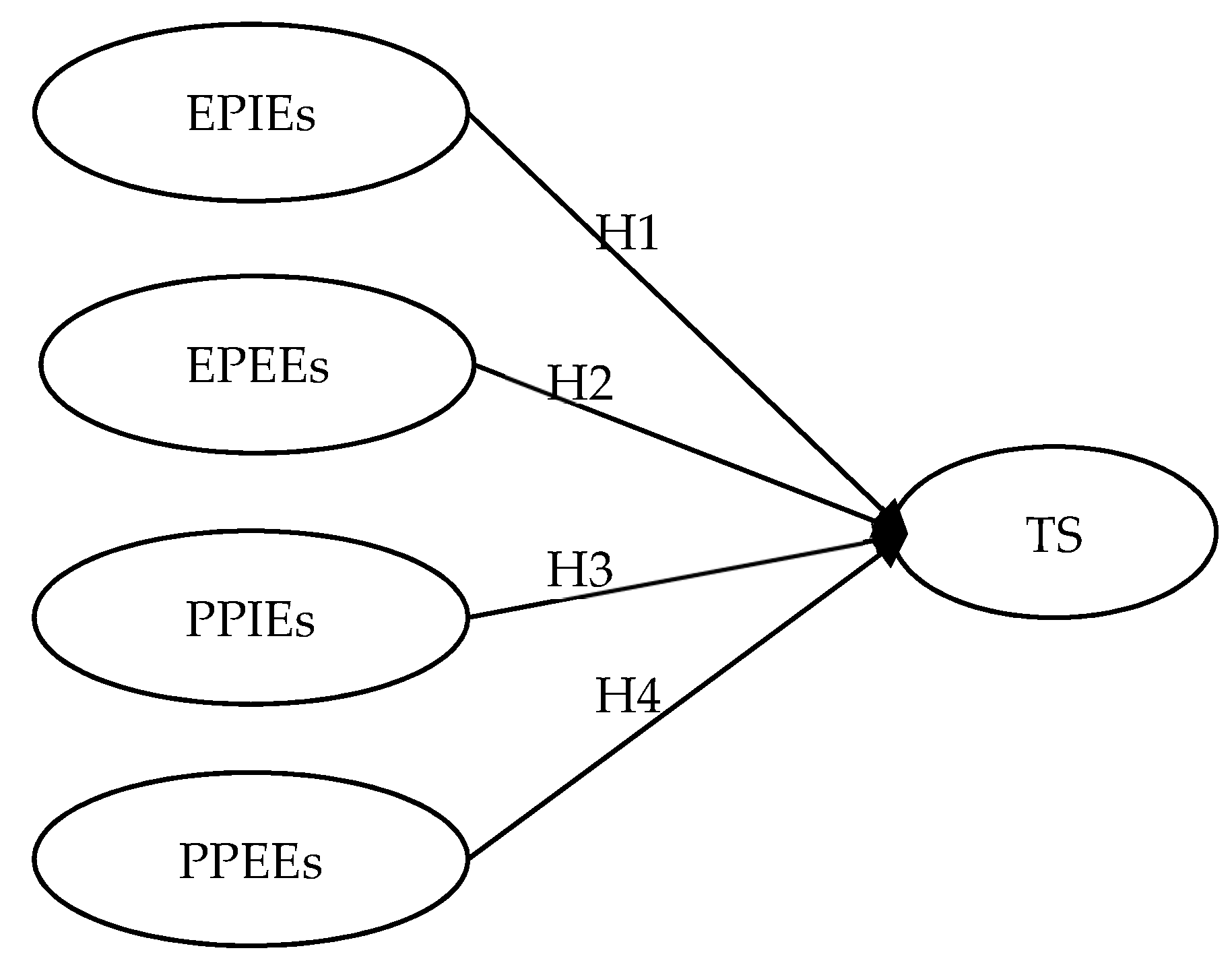
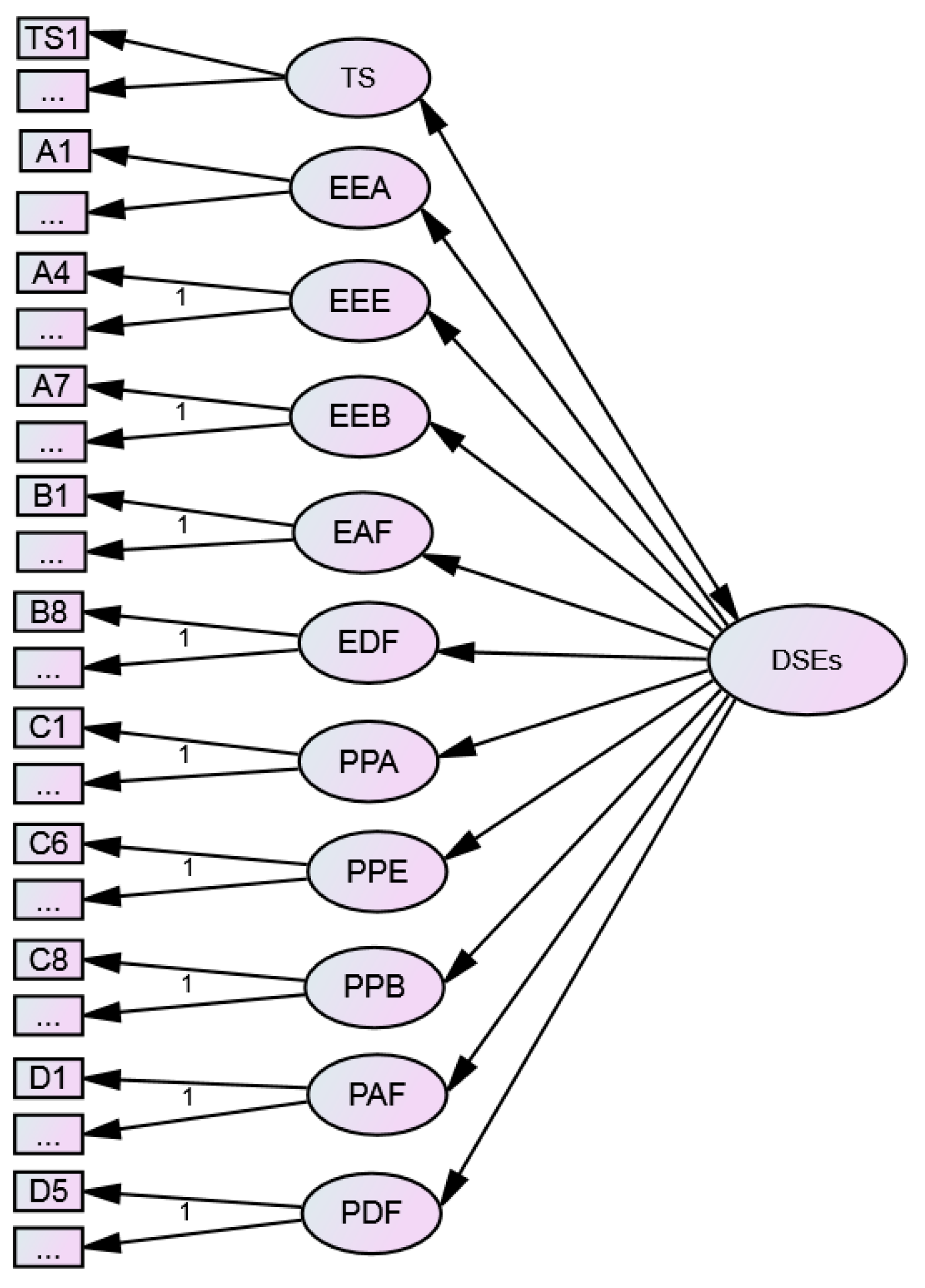
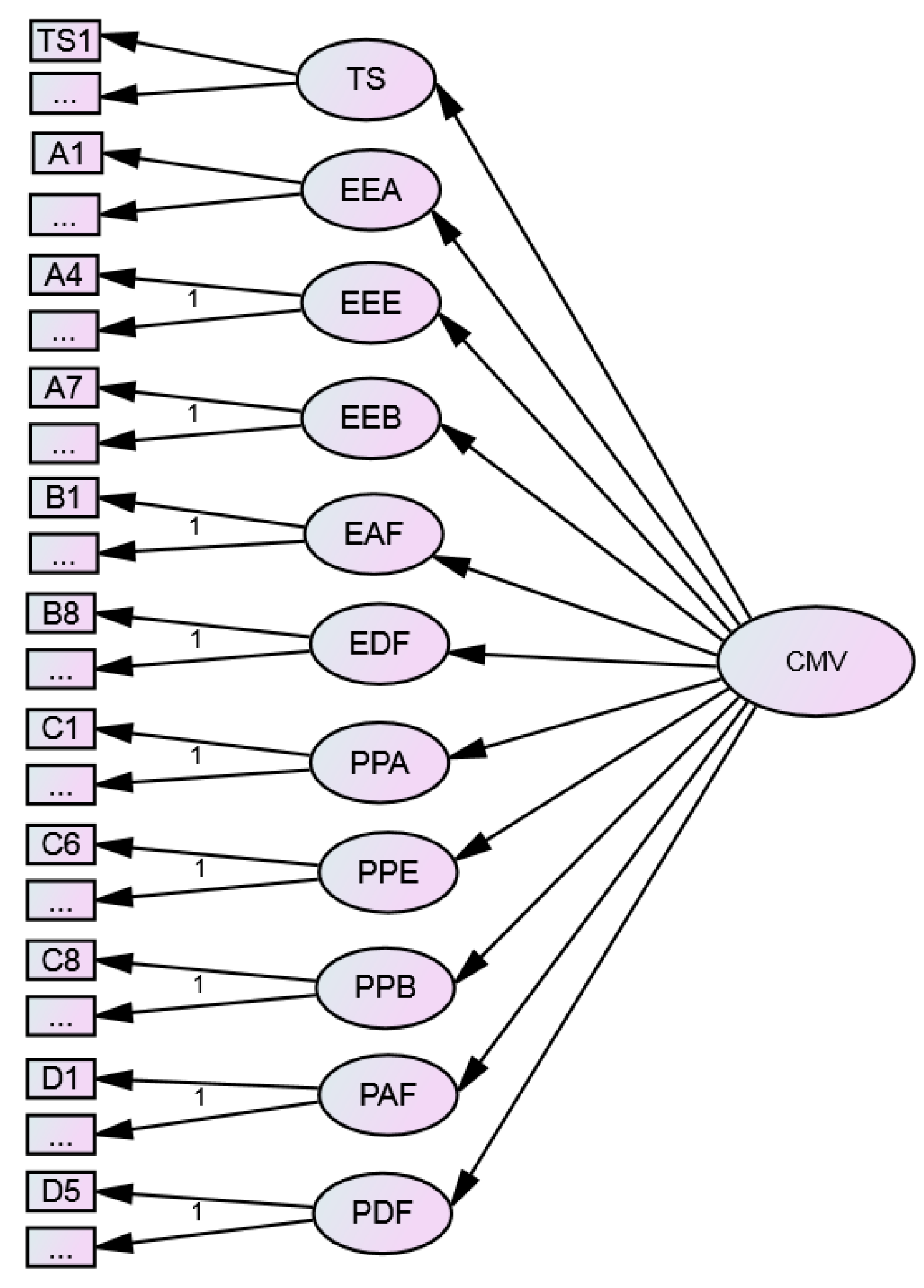
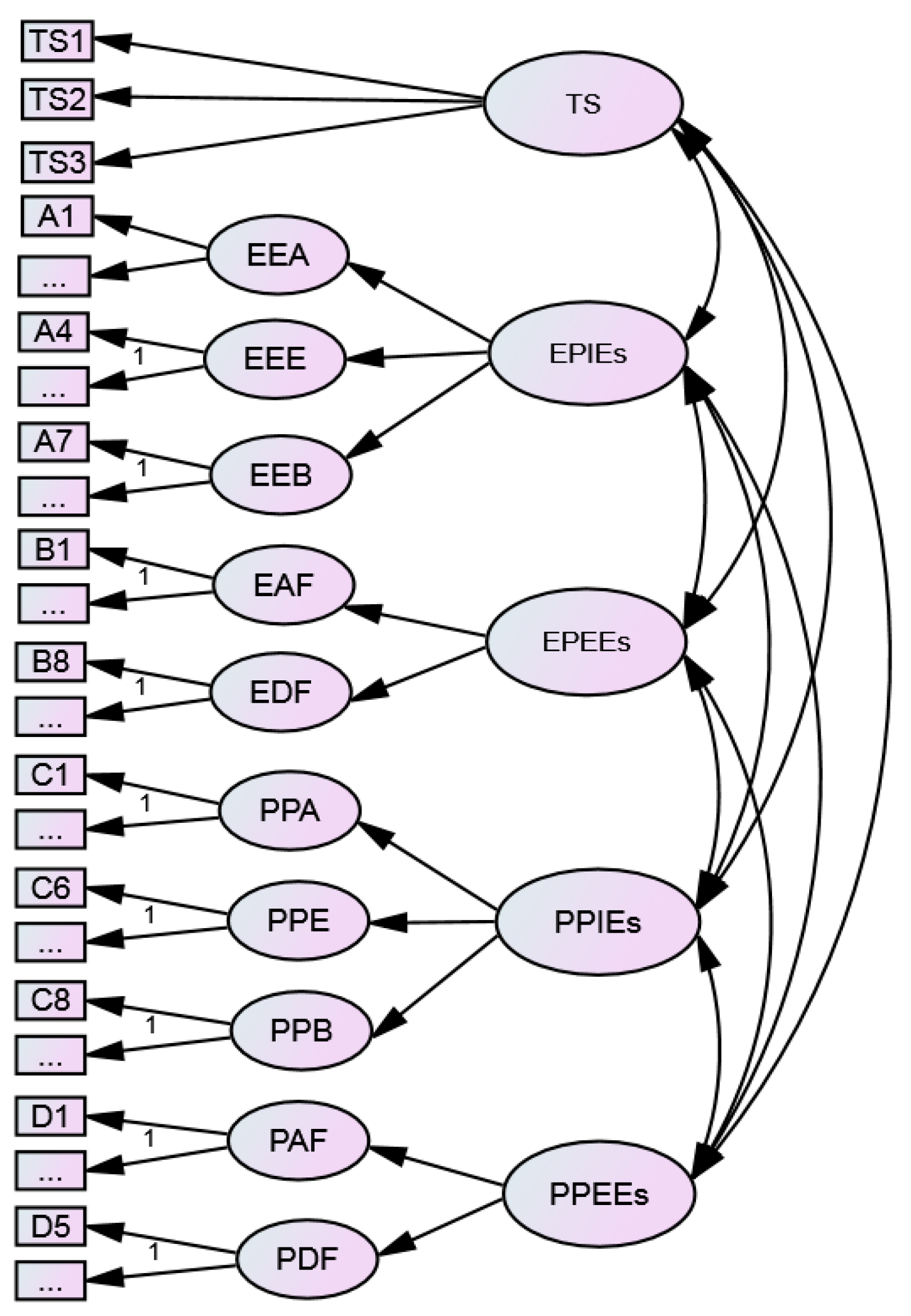
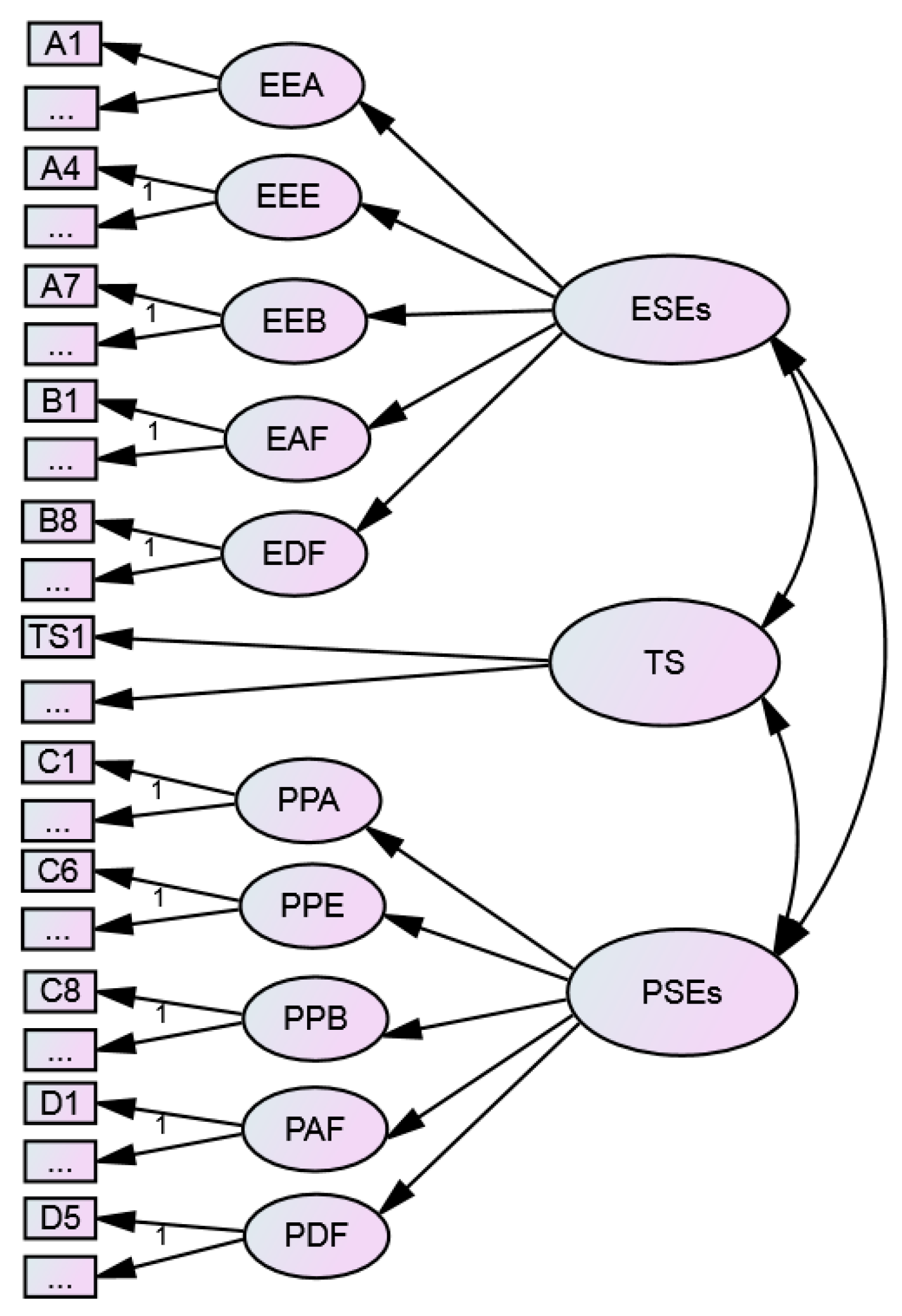
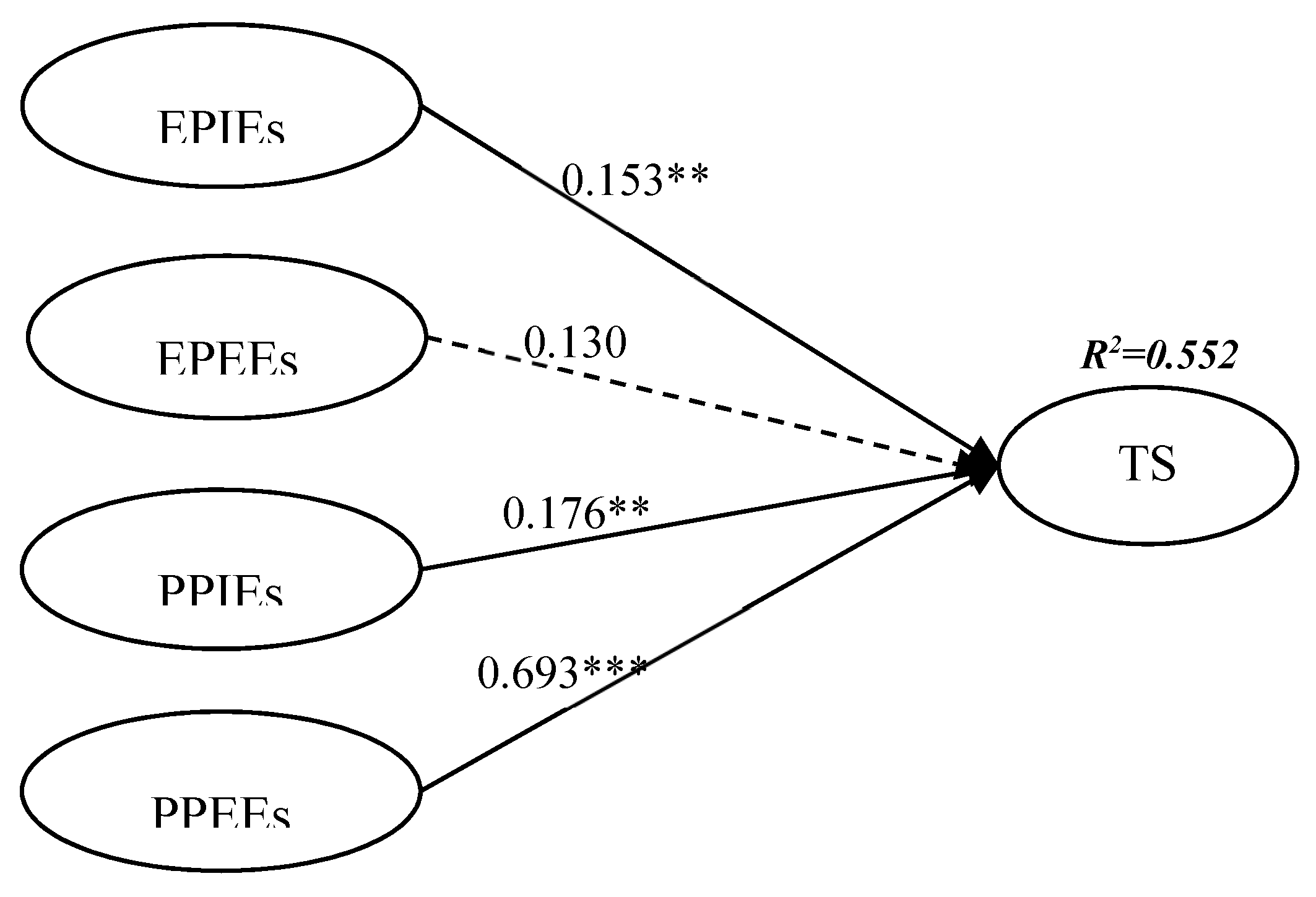
| Scholars | Main Points |
|---|---|
| Solomon, et al. (1985) | SE is the dyadic face-to-face interaction between a customer and a service provider. |
| Norman (1986) | SEs are a combination of contact moments (i.e., moments of truth) between customers and service employees. |
| Carlzon and Peters (1989) | |
| Gutek (1995) | SE is a customer’s accidental interaction with a service employee. SE only exists in the interaction between the two. |
| Shostack (1985) | SE is a customer’s direct interaction with a service during a period of time, not only with service employees, but also with facilities, new technologies and other tangible elements. |
| Bitner (1990) | |
| Lockwood (1994) | SE is a customer’s direct interaction with service delivery process in any period of time. This kind of interaction is not limited to the interaction between a customer and a service employee, but encompasses a customer’s interaction with service employees, physical environment, and other tangible and intangible elements. |
| Fitzsimmons, Fitzsimmons, and Bordoloi (2008) | SE is any customer’s interaction with a service organization, including its service staff, other customers, and the servicescape. |
| Voorhees, et al. (2017) | SE is any discrete interaction of a customer with a service provider during the core service process. |
| No | Gender | Age | Vocation | No | Gender | Age | Vocation |
|---|---|---|---|---|---|---|---|
| 1 | Female | 23 | Student | 14 | Female | 64 | Retiree |
| 2 | Female | 23 | Teacher | 15 | Male | 30 | Media Worker |
| 3 | Female | 23 | Student | 16 | Female | 67 | Retiree |
| 4 | Female | 23 | Sales Person | 17 | Female | 22 | Student |
| 5 | Female | 24 | Student | 18 | Female | 44 | Agent |
| 6 | Female | 23 | Service Employee | 19 | Female | 45 | Agent |
| 7 | Male | 25 | Sales Person | 20 | Male | 35 | Businessman |
| 8 | Male | 24 | Student | 21 | Male | 24 | Real estate Employee |
| 9 | Male | 62 | Retiree | 22 | Male | 26 | Freelance Worker |
| 10 | Male | 24 | Student | 23 | Male | 40 | Military Personnel |
| 11 | Male | 20 | Student | 24 | Male | 75 | Retiree |
| 12 | Male | 23 | Elevator | 25 | Female | 24 | Environmental Engineer |
| 13 | Female | 40 | Unemployed | 26 | Male | 28 | IT Engineer |
| Construct | Item Description | Source |
|---|---|---|
| Enterprise personal interaction encounters (EPIEs) | A1 The employees are friendly to me. | Brady and Cronin (2001) |
| A2 The employees are willing to help me. | ||
| A3 I can see from the employees’ attitudes that they understand my needs. | ||
| A4 The employees know their jobs well. | ||
| A5 The employees can answer my questions quickly. | ||
| A6 The employees can use their knowledge to meet my needs. | ||
| A7 The employees undertake actions to address my needs. | ||
| A8 The employees give quick responses to my needs. | ||
| A9 I can see from the employees’ behavior that they understand my needs. | ||
| Enterprise physical environment encounters (EPEEs) | B1 The enterprises have a pleasant smell. | Hightower, et al. (2002) |
| B2 The lighting is excellent in the enterprises. | ||
| B3 The enterprises are clean. | ||
| B4 The temperature in the enterprises is pleasant. | ||
| B5 The background music is appropriate. | ||
| B6 The background noise level in the enterprises is acceptable. | ||
| B7 The enterprises have more than enough space for me to be comfortable. | ||
| B8 The physical facilities in the enterprises are comfortable. | ||
| B9 The enterprises’ interior layout is pleasing. | ||
| B10 The signs used (i.e., bathroom, enter, exit, smoking) in enterprises are helpful to me. | ||
| B11 The restrooms are appropriately designed. | ||
| B12 The parking lot has more than enough space. | ||
| B13 The color scheme is attractive. | ||
| B14 The materials used inside the enterprises are pleasing and of high quality. | ||
| B15 The architecture is attractive. | ||
| B16 The style of the interior accessories is fashionable. | ||
| Public personal interaction encounters (PPIEs) | C1 The attitude of the public service personnel shows me that they are practical. | Sheng and Liu (2006); Wang and Li (2006) |
| C2 You can count on the personnel being responsible. | Semi-structured interviews | |
| C3 The attitude of the public service personnel demonstrates their strong service consciousness. | ||
| C4 The public service personnel provide considerate service to me. | ||
| C5 The public service personnel are able to respond quickly to my needs. | Sheng and Liu (2006) | |
| C6 You can count on the public service personnel being straightforward. | Wang and Li (2006) | |
| C7 The public service personnel can use their knowledge to meet my needs. | Semi-structured interviews | |
| C8 The behaviors of public service personnel indicate that they prioritize tourism. | ||
| C9 The behaviors of public service personnel indicate that they prioritize tourists. | ||
| C10 The public service personnel provide attentive service to me. | ||
| Public physical environment encounters (PPEEs) | D1 The destination is clean. | Semi-structured interviews |
| D2 The air in the destination is fresh. | ||
| D3 The destination has a pleasant landscape. | ||
| D4 The destination has good public security. | ||
| D5 The urban planning of the destination is reasonable. | Semi-structured interviews | |
| D6 The human landscape is in harmony with the natural landscape. | ||
| D7 The public facilities (toilets, waste containers, rest facilities, safety facilities) are more than enough. | ||
| D8 The public facilities (transportation, toilets) are comfortable. | Khadaroo and Seetanah (2007) | |
| D9 The public facilities (toilets, rest facilities) are clean. | ||
| D10 The public facilities (transportation, toilets, safety facilities, tourism public information) are convenient. | Semi-structured interviews | |
| D11 The destination has smooth traffic. | ||
| D12 The public facilities (transportation, trash can) are unique. | ||
| D13 The public facilities (toilets, rest facilities) are not damaged. | ||
| D14 The destination uses informatization and intelligent facilities (Application, Virtual Reality, Augmented Reality, interactive facilities, etc.). |
| Variables | N | Percentage | |
|---|---|---|---|
| Gender | Male | 232 | 50.8% |
| Female | 222 | 48.6% | |
| Missing | 3 | 0.7% | |
| Age | <15 | 40 | 8.8% |
| 15–24 | 120 | 26.3% | |
| 25–34 | 152 | 33.3% | |
| 35–44 | 94 | 20.6% | |
| 45–59 | 42 | 9.2% | |
| ≧60 | 7 | 1.5% | |
| Missing | 2 | 0.4% | |
| Education Level | Primary and below | 9 | 2.0% |
| Junior high school | 56 | 12.3% | |
| High school/secondary school/technical school | 118 | 25.8% | |
| Junior College | 83 | 18.2% | |
| Undergraduate College | 130 | 28.4% | |
| Master or above | 46 | 10.1% | |
| Missing | 15 | 3.3% | |
| Vocation | Enterprise Staff | 92 | 20.1% |
| Employees of government offices and institutions | 56 | 12.3% | |
| Individual Business | 30 | 6.6% | |
| Student | 131 | 28.7% | |
| Freelancer | 62 | 13.6% | |
| Retiree | 6 | 1.3% | |
| Unemployed | 3 | 0.7% | |
| Teacher | 31 | 6.8% | |
| Military Personnel | 9 | 2.0% | |
| Others | 31 | 6.78% | |
| Missing | 6 | 1.3% | |
| Average Monthly Income (RMB) | 0 | 134 | 29.3% |
| 1–1000 | 8 | 1.75% | |
| 1001–3000 | 106 | 23.2% | |
| 3001–5000 | 102 | 22.3% | |
| 5001–8000 | 34 | 7.4% | |
| 8001–10000 | 22 | 4.8% | |
| 10001–20000 | 11 | 2.4% | |
| >20000 | 25 | 5.5% | |
| Missing | 15 | 3.3% | |
| Construct | Dimension and item description | SL | TV | CR | AVE | SMC |
|---|---|---|---|---|---|---|
| Enterprise personal interaction encounters (EPIEs) | Attitude | 89 | 0.73 | |||
| A1 The employees are friendly to me. | 0.82 | N/A | 0.68 | |||
| A2 The employees are willing to help me. | 0.85 | 20.55 | 0.72 | |||
| A3 I can see from the employees’ attitudes that they understand my needs. | 0.89 | 20.48 | 0.80 | |||
| Expertise | 0.89 | 0.73 | ||||
| A4 The employees know their jobs well. | 0.83 | N/A | 0.69 | |||
| A5 The employees can answer my questions quickly. | 0.86 | 21.66 | 0.74 | |||
| A6 The employees can use their knowledge to meet my needs. | 0.88 | 20.52 | 0.77 | |||
| Behavior | 0.90 | 0.75 | ||||
| A7 The employees undertake actions to address my needs. | 0.89 | N/A | 79 | |||
| A8 The employees give quick responses to my needs. | 0.87 | 25.30 | 0.75 | |||
| A9 I can see from the employees’ behaviors that they understand my needs | 0.85 | 24.06 | 0.72 | |||
| Enterprise physical environment encounters (EPEEs) | Ambient Factors | 0.90 | 0.57 | |||
| B1 The enterprises have a pleasant smell. | 0.72 | N/A | 0.52 | |||
| B2 The lighting is excellent in the enterprises. | 0.71 | 20.19 | 0.51 | |||
| B3 The enterprises are clean. | 0.76 | 15.89 | 0.58 | |||
| B4 The temperature in the enterprises is pleasant. | 0.76 | 15.74 | 0.58 | |||
| B5 The background music is appropriate. | 0.79 | 16.25 | 0.62 | |||
| B6 The background noise level in the enterprises is acceptable. | 0.82 | 16.81 | 0.67 | |||
| B7 Enterprises have more than enough space for me to be comfortable. | 0.73 | 14.27 | 0.53 | |||
| Design Factors | 0.93 | 0.65 | ||||
| B8 The physical facilities in the enterprises are comfortable. | 0.85 | N/A | 0.72 | |||
| B9 The enterprises’ interior layout is pleasing. | 0.85 | 23.10 | 0.72 | |||
| B10 The signs used (i.e., bathroom, enter, exit, smoking) in enterprises are helpful to me. | 0.78 | 18.35 | 0.60 | |||
| B11 The restrooms are appropriately designed. | 0.77 | 19.30 | 0.59 | |||
| B13 The color scheme is attractive. | 0.81 | 21.23 | 0.66 | |||
| B14 The materials used inside the enterprises are pleasing and of high quality. | 0.80 | 20.56 | 0.64 | |||
| B16 The style of the interior accessories is fashionable. | 0.78 | 19.96 | 0.61 | |||
| Public personal interaction encounters (PPIEs) | Attitude | 0.95 | 0.87 | |||
| C1 The attitude of the public service personnel shows me that they are practical. | 0.92 | N/A | 0.85 | |||
| C2 You can count on the personnel being responsible. | 0.97 | 38.29 | 0.93 | |||
| C3 The attitude of the public service personnel demonstrates their strong service consciousness. | 0.91 | 31.42 | 0.84 | |||
| Expertise | 0.93 | 0.81 | ||||
| C6 You can count on the public service personnel being straightforward. | 0.90 | N/A | 0.82 | |||
| C7 The public service personnel can use their knowledge to meet my needs. | 0.89 | 29.02 | 0.80 | |||
| C10 The public service personnel provide attentive service to me. | 0.90 | 27.19 | 0.80 | |||
| Behavior | 0.90 | 0.82 | ||||
| C8 The behaviors of public service personnel indicate that they prioritize tourism. | 0.85 | N/A | 0.72 | |||
| C9 The behaviors of public service personnel indicate that they prioritize tourists. | 0.96 | 25.66 | 0.93 | |||
| Public physical environment encounters (PPEEs) | Ambient Factors | 0.87 | 0.63 | |||
| D1 The destination is clean. | 0.78 | N/A | 0.61 | |||
| D2 The air in the destination is fresh. | 0.80 | 20.03 | 0.64 | |||
| D3 The destination has a pleasant landscape. | 0.80 | 17.68 | 0.65 | |||
| D4 The destination has good public security. | 0.79 | 17.15 | 0.63 | |||
| Design Factors | 0.93 | 0.67 | ||||
| D5 The urban planning of the destination is reasonable. | 0.77 | N/A | 0.59 | |||
| D7 The public facilities (toilets, waste containers, rest facilities, safety facilities) are more than enough. | 0.81 | 18.42 | 0.66 | |||
| D8 The public facilities (transportation, toilets) are comfortable. | 0.85 | 19.56 | 0.72 | |||
| D10 The public facilities (transportation, toilets, safety facilities, tourism public information) are convenient. | 0.85 | 17.77 | 0.72 | |||
| D11The destination has smooth traffic. | 0.75 | 16.88 | 0.57 | |||
| D12 The public facilities (transportation, waste containers) are unique. | 0.86 | 19.62 | 0.73 | |||
| D13The public facilities (toilets) are not damaged. | 0.84 | 19.27 | 0.71 |
| Models | χ2 | df | χ2 | χ2/df | GFI > 0.90 | CFI > 0.90 | TLI > 0.90 | NFI > 0.90 | RMSEA < 0.08 | SRMR < 0.05 |
|---|---|---|---|---|---|---|---|---|---|---|
| Model D | 1792.365 | 903 | 1.985 | 0.855 | 0.955 | 0.95 | 0.913 | 0.046 | 0.034 | |
| Model C | 2422.105 | 917 | 629.74 *** | 2.641 | 0.802 | 0.923 | 0.917 | 0.883 | 0.06 | 0.080 |
| Model B | 2631.213 | 917 | 838.843 *** | 2.869 | 0.791 | 0.913 | 0.906 | 0.873 | 0.064 | 0.057 |
| Model A | 2631.213 | 917 | 838.843 *** | 2.869 | 0.791 | 0.913 | 0.906 | 0.873 | 0.064 | 0.057 |
© 2019 by the authors. Licensee MDPI, Basel, Switzerland. This article is an open access article distributed under the terms and conditions of the Creative Commons Attribution (CC BY) license (http://creativecommons.org/licenses/by/4.0/).
Share and Cite
Zhou, M.; Wang, F.; Wang, K. Destination Service Encounter Modeling and Relationships with Tourist Satisfaction. Sustainability 2019, 11, 960. https://doi.org/10.3390/su11040960
Zhou M, Wang F, Wang K. Destination Service Encounter Modeling and Relationships with Tourist Satisfaction. Sustainability. 2019; 11(4):960. https://doi.org/10.3390/su11040960
Chicago/Turabian StyleZhou, Meijing, Fuyuan Wang, and Kaiyong Wang. 2019. "Destination Service Encounter Modeling and Relationships with Tourist Satisfaction" Sustainability 11, no. 4: 960. https://doi.org/10.3390/su11040960
APA StyleZhou, M., Wang, F., & Wang, K. (2019). Destination Service Encounter Modeling and Relationships with Tourist Satisfaction. Sustainability, 11(4), 960. https://doi.org/10.3390/su11040960




